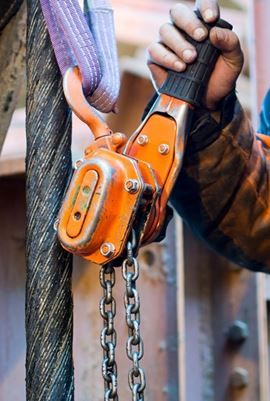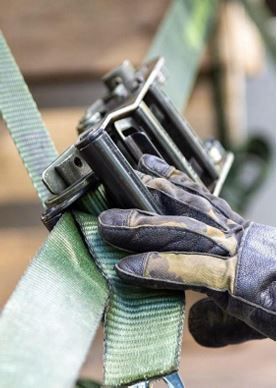News
How Does a Lever Block work?
A lever hoist (also known as a lever block) is
a manual lifting and pulling device used for
lifting, lowering, and tensioning loads
through a ratcheting lever mechanism. It is
frequently called by both names,
depending on the region or manufacturer,
and is widely used in construction,
manufacturing, shipping, and maintenance
work.
• A lever hoist consists of a strong
frame, a load chain, lifting hook, a
ratcheting lever handle, and an
internal gearing system.
• The device operates by moving the
lever handle back and forth, which
rotates the gears internally to lift or
lower the attached load.
• Typically rated for loads ranging
from 250 kg to 9 tons, depending on
size and construction.
A lever hoist works by using a lever handle that operates a ratchet and pawl mechanism inside
the device, allowing for controlled lifting, lowering, or tensioning of heavy loads with modest
manual effort.
Lever Hoist Mechanism
• The hoist features a sturdy frame with a lever handle attached to a block containing an
internal ratchet and gear system.
• As the user moves the lever back and forth, the ratchets inside the block engage and
rotate the drum, which is wound with a chain.
• This ratcheting action incrementally moves the chain, providing the mechanical
advantage needed to lift or lower loads.
Modes of Operation
• Most lever hoists have a directional switch or selector (up, down, neutral) that controls
whether the handle strokes lift, lower, or allow free-spooling of the chain for quick
rigging.
• When the selector is set to "up" cranking the lever raises the load. When set to "down"
operating the lever lowers the load. Neutral allows the chain to be adjusted without
tension.
• The hoist's brake or pawl securely holds the load between lever strokes, preventing
uncontrolled movement.
Safety Features
• Lever hoists are equipped with safety hooks, reliable braking mechanisms, and
overload protection(optional) to ensure safe handling and secure positioning of heavy
objects.
• They are available in various sizes, materials, and capacities to suit different
operational needs.
Every lever hoist relies on mechanical advantage and simple physics to make lifting heavy loads
safer and easier in environments without electric or hydraulic power sources.
Click here to view our Lever block range.
What is Cargo Lashing?
Cargo lashing is the
process of securing cargo
during transport to prevent
it from shifting, sliding, or
moving, which could
damage the goods or cause
accidents.
It is essential for ensuring
the safety and integrity of
the cargo as well as the
transportation means.
Lashing involves using
various securing materials
such as ropes, straps,
chains, cables, or nets,
which are anchored to the
transport vehicle (like a
ship, truck, or container)
and tensioned against the
cargo to hold it firmly in
place.
Main Functions
• Stability: Prevents cargo from moving due to ship rolling, braking, or turbulence.
• Safety: Protects workers, equipment, and the cargo itself.
• Compliance: Meets international regulations (e.g., IMO, ISO, EN standards).
Typical Components
1. Lashing Materials
o Lashing straps (webbing) – polyester belts with ratchets or buckles.
o Chains & binders – used for heavy-duty cargo (e.g., vehicles, steel coils).
o Wire ropes – strong but less flexible, often used in maritime transport.
2. Securing Devices
o Turnbuckles, tensioners, ratchets – tighten and hold lashings.
o Hooks, shackles, D-rings – connection points.
o Corner protectors & edge guards – prevent damage to cargo and
lashings.
3. Fixed Anchors
o Lashing eyes, rails, tracks – built into vessels, trucks, or containers to
provide secure attachment points.
Types of Cargo Lashing Systems
• Container lashing system – twistlocks, lashing rods, turnbuckles to secure
stacked containers on ships.
• RoRo (Roll-on/Roll-off) lashing system – chains, belts, and wheel chocks for
vehicles.
• Flat rack or breakbulk lashing system – straps, chains, dunnage for
oversized/irregular cargo.
Click here to view our lashing range.
The Ratchet Tie Down Strap
represents a significant innovation in
load securing, particularly in
industries like logistics, construction,
and transportation. This strap
combines ergonomic design with
robust performance, making it a
preferred choice for professionals.
In the logistics, construction, and transportation industries, securing heavy loads safely and
efficiently is critical. The Ratchet Tie Down Strap stands out as a game-changer in cargo
securement, combining ergonomic design with robust performance. Below, we explore its key
advantages and diverse applications to help you understand why it’s a preferred choice for
professionals.
Key Advantages of Ratchet Tie Down Strap
1. Ergonomic Design for Reduced Strain
Unlike traditional ratchet straps that require upward pushing, Ratchets feature a downward
pulled handle, significantly reducing the force needed to achieve tension. This design
minimizes back strain and operator fatigue, making it ideal for repetitive tasks or long-haul
transport scenarios.
2. High Load Capacity and Durability
Made from 100% polyester webbing with low elongation (≤7%), these straps maintain tension
under heavy loads. They offer a lashing capacity (LC) of up to 5,000 kg (11,000 lbs) and comply
with the EN12195-2 standard, ensuring reliability in demanding environments.
3. Enhanced Safety Features
With a safety factor of 2:1 or 3:1, ratchets provide a margin of safety beyond their rated capacity.
The reinforced hooks and corrosion-resistant hardware further prevent accidental release, even
in harsh weather conditions.
4. Ease of Use and Versatility
The intuitive ratchet mechanism enables quick tensioning and release, while the variety of end
fittings (S-hooks, J-hooks) ensures compatibility with different anchor points, from truck beds to
shipping containers.
Applications Across Industries
1. Transportation and Logistics
Cargo Securement: Ideal for stabilizing pallets, machinery, and construction materials on
trucks, ships, or railcars. The ergonomic design is particularly beneficial for drivers and
dockworkers handling multiple loads daily.
Automotive Transport: Safely secure motorcycles, ATVs, or vehicles during transit, leveraging
the strap’s high tensile strength to prevent shifts on uneven roads.
2. Construction and Heavy Machinery
Equipment Fixing: Use ratchets to anchor excavators, generators, or steel beams at
construction sites. Their durability withstands abrasive surfaces and dynamic loads.
Scaffolding Stability: Temporarily secure scaffolding components during assembly or
disassembly.
3. Agriculture and Forestry
Hay Bale and Lumber Transport: The polyester webbing resists moisture and UV damage,
making it suitable for outdoor use in farming or forestry operations.
Livestock Barriers: Create temporary enclosures or secure trailers transporting animals.
4. Marine and Offshore Operations
Cargo Nets and Container Lashing: The corrosion-resistant materials and high load
capacity make straps reliable for maritime applications, even in saltwater environments.
5. Event Management and Temporary Installations
Stage Rigging and Equipment Anchoring: Secure lighting, sound systems, or temporary
structures at outdoor events.
Why Choose Ratchet Straps Over Traditional Options?
1. Efficiency: The ergonomic handle reduces tightening time by up to 30%, as demonstrated by
tools like the Strap semi-automatic strapping machine, which prioritizes operator comfort and
workflow speed.
2. Cost-Effectiveness: Lower risk of workplace injuries translates to reduced downtime and
insurance costs.
3. Regulatory Compliance: Meeting standards like EN12195-2 ensures adherence to EU
safety regulations, avoiding fines or cargo rejections.
Best Practices for Using Ratchet Straps
1. Inspect Regularly: Check for frayed webbing, rusted hooks, or damaged ratchets before each
use.
2. Use Edge Protectors: Prevent abrasion when securing sharp-edged cargo.
3. Avoid Overloading: Adhere to the WLL and distribute tension evenly across multiple straps
for heavy loads.
Conclusion
Ratchet Tie Down Straps redefine cargo securement by prioritizing operator safety,
efficiency, and compliance. Whether you’re transporting construction equipment,
agricultural goods, or marine cargo, their ergonomic design and robust construction
make them indispensable.
















